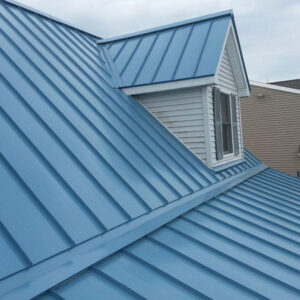A roof provides protection from weather elements and helps keep the interior dry and cool. There are many different types of roofs including flat, low-
 slope, high-slope, and steeply pitched roofs. Each
slope, high-slope, and steeply pitched roofs. Each
type of roof serves a specific purpose. Flat roofs protect buildings from rainwater runoff, while low-sloped roofs provide shade and help prevent overheating. High-sloped roofs allow airflow between the inside and outside of a building. Steeply sloped roofs are designed to shed snow and ice.
Types of Commercial Roofing Materials
There are several types of commercial roofing materials. These include asphalt shingle, metal roofing, tile roofing, concrete roofing, and slate roofing. Asphalt shingles are the most popular material for commercial roofing. Metal roofing is becoming increasingly popular due to its durability and longevity. Tile roofing is an excellent option if you want to add some character to your roof. Concrete roofing is durable and long-lasting. Slate roofing is expensive and requires professional installation.
Types of Commercial Roofing Systems
Built-up roofs are the most common type of commercial roofing system used today. They consist of several layers of material, including cementitious materials, asphalt shingles, metal decking, insulation, and waterproof membranes. These layers protect against water damage, hail, wind uplift, and fire.
The built-up roofing industry includes many products such as single-ply membranes, modified bitumen roofing, and built-up roofing. Each type of product offers advantages and disadvantages over another.
Modified Bitumen Commercial Roofs
Also known as mod-bit, a modified bitumen roofing system combines asphaltic materials and reinforcing fibers. These roofs are designed to withstand extreme weather conditions such as heavy snowfall and high winds. They provide excellent resistance against leaks and hail damage. In addition, it offers superior thermal insulation properties. It is fastened to the rooftop as a two-ply system. This ensures maximum protection and stability. Mod-bit roofs are easy to install and require minimal maintenance. They are ideal for industrial sites, warehouses, retail stores, schools, hospitals, and government buildings.
EPDM & TPE Commercial Roofing Membranes
EPDM membranes are used for roofing applications because of their durability, weather resistance, ease of application, and low cost. These membranes come in different thicknesses, colors, and textures, allowing architects and builders to choose the best option based on budget and aesthetic needs.
The most common type of roof membrane is a thermoplastic elastomer (TPE), which comprises polymers and additives. TPE membranes are flexible and have good resistance to chemicals and UV radiation. They are also resistant to temperature changes, making them ideal for use in cold climates.
PVC & TPO Commercial Roof Membranes
Poly Vinyl Chloride (also known as PVC) and thermoplastic polyolefins (TPOs) are the best roof membranes for second-generation applications. These materials are used for roofing, siding, skylights, windows, doors, gutters, and rainwater management. They are lightweight, resistant against UV rays, punctures, and most chemicals and bacteria, and highly reflective.
Increasing demand for energy efficiency and sustainability initiatives is driving the adoption of green building technologies such as solar panels, LED lighting, and renewable power sources.
Commercial Roofing Considerations
Commercial roofs are one of the most important investments you make in your property. They protect against damage caused by extreme weather conditions, such as rain, snow, hail, wind, sun exposure, and even earthquakes. In addition, commercial roofs protect against fire, insects, and rodents. A properly installed commercial roof can add value to your property, extend its life expectancy, and improve energy efficiency.
When selecting a roof type, there are several factors to consider. These include the cost per square foot, durability, longevity, maintenance requirements, ease of installation, and aesthetics.
The costs associated with installing a commercial roof depend on the type of roofing material being used, the size of the building, the location where it is located, and whether the roof needs repair or replacement. For example, a traditional flat roof might require less labor than a pitched roof because fewer seams must be sealed. However, a larger area of a pitched roof requires more sealing than a smaller area of a flat roof.
Installation costs
The cost of installing a commercial roof varies depending on the project’s size and location. Costs depend on the roofing material installed and whether the job is done professionally or DIY. Large projects may require specialized equipment and skilled labor. Smaller jobs may only need basic tools and do not require highly trained workers.
Maintenance costs
Commercial roof maintenance includes inspecting the roof for damage, repairing any leaks, cleaning the roof, and replacing damaged parts. Depending on how often the roof is inspected, maintenance costs vary. If the roof is inspected less frequently than recommended, then the cost of maintaining the roof increases. Regular inspections ensure that the roof is safe and functioning correctly.
What Is the Lifespan of my Current Roof?
The lifespan of a commercial roof varies depending on the material used to construct it. EPDM roofs typically last up to 30 years; PVC roofs can last up to 20 years; TPO roofs usually last around 15 to 20 years before needing replacement.
Commercial Roof Inspection
It is essential to know what to look for when inspecting your roof. Look for signs of wear and tear such as loose flashing, missing shingles, cracked tiles, and damaged gutters. These problems could lead to water leaking into your facility and causing severe damage. If you don’t feel confident inspecting your commercial roof in Englewood, call RME Roofing, and we’ll send a commercial roofing expert to perform an inspection. Call us at 720-663-7766.
Insurance coverage
Insurance companies offer insurance policies for commercial roofing. Policies cover everything from property loss to worker compensation. Most insurance policies have deductibles limiting the amount of money you pay out of pocket before the insurance company pays anything. Insurers also charge higher rates for larger projects.

